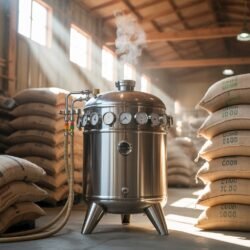If you’re a coffee roaster looking to get the most out of anaerobically fermented beans, you’re in for an exciting—and sometimes challenging—journey. Anaerobic coffees are renowned for their vibrant, complex profiles, but unlocking those flavors in the roaster requires a thoughtful approach. Here’s what you need to know to roast anaerobically fermented coffee at its best.
Start with the Details
Before you even turn on your roaster, take time to learn as much as you can about the specific anaerobic process used for your beans. Did the producer aim for lactic acid development? Was the Brix (sugar content) particularly high? Knowing these details can guide your roasting decisions and help you anticipate how the beans might behave.
Size Matters: Smaller Batches for Better Control
Anaerobic coffees are often denser and more complex than their traditional counterparts. To ensure even development and avoid under- or over-roasting, consider roasting in smaller batches. This gives you greater control over heat application and allows the unique flavors of the coffee to shine.
Mastering Roast Development
One of the hallmarks of anaerobically fermented coffee is its layered, nuanced flavor profile. To bring out the best in these beans, aim for a slightly extended development phase after first crack—about 16–17% of the total roast time. This gentle approach helps preserve the coffee’s natural sweetness and acidity, resulting in a more balanced and expressive cup.
Heat Management: Slow and Steady Wins the Race
Anaerobic beans can be tricky when it comes to heat transfer. You might notice a slower turning point at the start of the roast, so be prepared to adjust your heat application accordingly. Avoid cranking up the heat in the late stages, as this can overwhelm delicate flavors and introduce unwanted bitterness.
The Final Touch: Temperature and Rest
To truly honor the complexity of anaerobically fermented coffee, keep your final roast temperature below 200°C. This helps protect the delicate aromatics and prevents the coffee from tasting harsh or burnt. After roasting, give the beans a little extra time to rest—about a month, rather than the usual 10–14 days. This extended rest allows the flavors to settle and integrate, resulting in a smoother, more harmonious cup.
Embrace Experimentation
Every batch of anaerobically fermented coffee is unique, so don’t be afraid to experiment with your roast profiles. Share your results with producers and fellow roasters to refine your technique and deepen your understanding of these remarkable beans.
Final Thoughts
Roasting anaerobically fermented coffee is a rewarding challenge for any coffee professional. By paying attention to processing details, roasting in smaller batches, carefully managing development and heat, and allowing for a longer rest period, you can unlock the full potential of these extraordinary coffees. The result? A cup that’s as complex and memorable as the process that created it.


